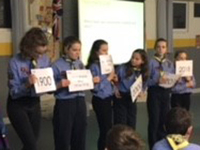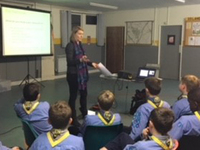- County name: Oxfordshire
- Group/School name: 33rd Oxford (Kidlington) Sea Scout Troop RN102
- Age group: 11+
- Group type: Sea Scouts
Towards the end of summer 2018, War Memorials Trust received a visit enquiry from the leader of 33rd Oxford (Kidlington) Sea Scouts. The leader was putting together the timetable for meetings in the autumn term and was keen that one of the meetings focused on war memorials. Some of the Sea Scouts had attended the Remembrance Day parade at the local war memorial on Kidlington so had some existing understanding but the leader was keen for this to be developed further. The visit took place in the week following Remembrance Sunday.
The first part of the session focused on the question What is a war memorial? The Sea Scouts shared their ideas and then the variety of war memorials erected across the UK was further highlighted using local examples. When sharing these local examples and the history of them, it was noted that some of the World War I dates were 1914-1918 and others were 1914-1919. Through discussion it was established this was due to the Treaty of Versailles being signed in June 1919. The Sea Scouts then learnt how many war memorials there are in the UK, when many were created and why the majority were created following the end of World War I.
After a short break the focus of the session shifted to the names on the war memorial outside the Church of St Mary the Virgin in Kidlington (www.warmemorialsonline.org.uk/memorial/179583). The Sea Scouts were asked for their initial observations about the names. These included that:
-
Some names appear 2, 3 or even 4 times.
- Bowerman appears 4 times.
- Names are listed alphabetically.
- The names of Mrs Timms’s three sons were found. Mrs Timms unveiled the war memorial because she lost 3 sons in a 4 month period during World War I
The Sea Scouts were then told how they could go about researching the men named on the war memorial. The Commonwealth War Graves Commission was suggested as a useful starting point but it was also highlighted that sources including military records, birth, marriage and death certificates, census and local newspapers are also useful.
The information, from CWGC’s Find War Dead database, about four people named on the war memorial was then shared with the Sea Scouts. They were asked to consider why these men in particular had been chosen
- Brothers, Francis H and Frederick Bowerman, who died within 6 weeks of each other
- Arthur Drewitt who died on the same date as the visit, 102 years ago
- Montague Witts, an Ordinary Seaman, on-board HMS “Surprise”. WMT’s Learning Officer was able to show an image of the ship and also explain when and how the ship had sunk. Out of 55 crew only 7 survived.
While looking at the research, the Sea Scouts commented on the number of casualties in the CWGC cemetery or recorded on the CWGC memorial. They ranged from 59 in Welsh Cemetery (Caesar’s Nose) in West-Vlaanderen, Belgium to 72,337 on Thiepval memorial.
Thoughts then turned to some of the problems facing war memorials and the Sea Scouts identified a good range of possibilities. Subsequently they were shown an example of a memorial nearby which had not been cleaned since being erected in 1920. The memorial received a grant from WMT in 2013 allowing it to be cleaned and for the cross to be replaced as it appeared to have been inappropriately treated in the past resulting in severe cracking and delamination. The Sea Scouts were amazed by the difference between the before and after photographs and the clarity of the letters following the work.
To end the session, the Sea Scouts were given a quick quiz during which they had to show whether they agreed or disagreed with the following statements.
- The majority of war memorials in the UK were created after the First World War
- Communities had to follow lots of rules when designing and erecting their war memorial
- The facts the fallen were not repatriated resulted in wave of memorialisation in the UK following the First World War
- War memorials should continue to be an important site within the community
Some of the Sea Scouts then shared their reasons for agreeing or disagreeing. One of the reasons given for agreeing with the final statement was that “they gave their lives so that we could live today”. Following session this Sea Scout came and spoke to our Learning Officer and said that he lived in Chesterton – one of the local war memorials that had been shown earlier on. He had not realised the lychgate was a war memorial but said he would now look at it through new eyes. He also mentioned that he had heard a quote which said “for your tomorrow, we gave our today”. This linked back to the reason why he felt war memorials were so important.
It was an absolute pleasure to work with this Sea Scout troop. They fully engaged with all the activities and made some very thoughtful comments. Hopefully they will be able to look at the war memorial in Kidlington, and others in their local area, with more developed understanding as a result of what they learnt during the session.





